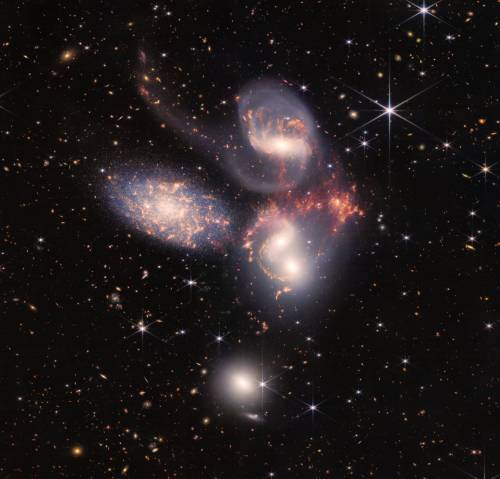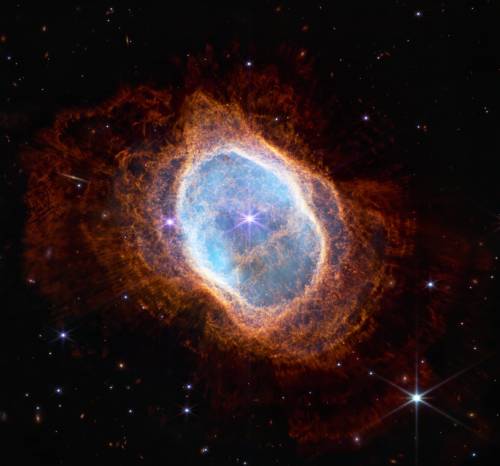Btw . Insane Little Wikipedia Caption For Everyone’s Consideration Also
![Screenshot from nebula Wikipedia page: The "Pillars of Creation" from the Eagle Nebula. Evidence from the Spitzer Space Telescope suggests that the pillars may already have been destroyed by a supernova explosion, but the light showing us the destruction will not reach the Earth for another millennium.[1]](https://64.media.tumblr.com/b10fae13b89258a4bbd4b2cd7cf10646/939e648398194b92-95/s500x750/dd77cb9b6f24b0eaca6ca04b691a327c71641d09.jpg)
btw . insane little wikipedia caption for everyone’s consideration also
More Posts from Of-finite-jurisdiction and Others



NASA’s Webb Space Telescope Reveals Astounding, Unprecedented Views of the Universe

Jupiter Rotates : Observe the graceful twirl of our Solar System’s largest planet. Many interesting features of Jupiter’s enigmatic atmosphere, including dark belts and light zones, can be followed in detail. A careful inspection will reveal that different cloud layers rotate at slightly different speeds. The famous Great Red Spot is not visible at first – but soon rotates into view. Other smaller storm systems occasionally appear. As large as Jupiter is, it rotates in only 10 hours. Our small Earth, by comparison, takes 24 hours to complete a spin cycle. The featured high-resolution time-lapse video was captured over five nights earlier this month by a mid-sized telescope on an apartment balcony in Paris, France. Since hydrogen and helium gas are colorless, and those elements compose most of Jupiter’s expansive atmosphere, what trace elements create the observed colors of Jupiter’s clouds remains a topic of research. via NASA
this is my space centered blog, sharing in case any of you guys like space too :^)
how I sleep at night knowing there are stars and planets and galaxies above my roof











“Black Hole,” poem assembled from quotations from Wikipedia articles


Neptune’s rings in infrared © JWST
SNOOPY IS BACK FROM THE MOON


NGC 6960, Witch’s Broom

Zeta Ophiuchi: A Star With a Complicated Past via NASA https://ift.tt/78Esywl
A Dusty Fingerprint in Space

A new image from NASA's James Webb Space Telescope reveals a remarkable cosmic sight: at least 17 concentric dust rings emanating from a pair of stars. Just 5,300 light-years from Earth, the star duo are collectively known as Wolf-Rayet 140. Each ring was created when the two stars came close together and their stellar winds (streams of gas they blow into space) collided so forcefully that some of the gas was compressed into dust. The stars' orbits bring them together about once every eight years, and forms a half-shell of dust that looks like a ring from our perspective. Like a cosmic fingerprint, the 17 rings reveal more than a century of stellar interactions—and the "fingerprint" belonging to Wolf-Rayet 140 may be equally unique. Other Wolf-Rayet stars produce dust, but no other pair are known to produce rings quite like Wolf-Rayet 140.
Learn more about Wolf-Rayet 140.
Make sure to follow us on Tumblr for your regular dose of space!
-
 clairvoyant-sky liked this · 1 month ago
clairvoyant-sky liked this · 1 month ago -
 oceanara liked this · 3 months ago
oceanara liked this · 3 months ago -
 snicklesnek liked this · 3 months ago
snicklesnek liked this · 3 months ago -
 flower-wizard reblogged this · 3 months ago
flower-wizard reblogged this · 3 months ago -
 flower-wizard liked this · 3 months ago
flower-wizard liked this · 3 months ago -
 tolls4thee reblogged this · 3 months ago
tolls4thee reblogged this · 3 months ago -
 wordcubed liked this · 3 months ago
wordcubed liked this · 3 months ago -
 flyingnana liked this · 4 months ago
flyingnana liked this · 4 months ago -
 lovelybeachestaketime liked this · 4 months ago
lovelybeachestaketime liked this · 4 months ago -
 approximately-32-leafcutter-ants reblogged this · 4 months ago
approximately-32-leafcutter-ants reblogged this · 4 months ago -
 lumi-lightner liked this · 4 months ago
lumi-lightner liked this · 4 months ago -
 thankchaosforspellcheck reblogged this · 4 months ago
thankchaosforspellcheck reblogged this · 4 months ago -
 thankchaosforspellcheck liked this · 4 months ago
thankchaosforspellcheck liked this · 4 months ago -
 forgetme-eternally-blissfully reblogged this · 4 months ago
forgetme-eternally-blissfully reblogged this · 4 months ago -
 storiesbybly reblogged this · 5 months ago
storiesbybly reblogged this · 5 months ago -
 sky-fi-fangirl liked this · 5 months ago
sky-fi-fangirl liked this · 5 months ago -
 cuckerfailson liked this · 5 months ago
cuckerfailson liked this · 5 months ago -
 celestial-sappho reblogged this · 5 months ago
celestial-sappho reblogged this · 5 months ago -
 vintagenightwing liked this · 6 months ago
vintagenightwing liked this · 6 months ago -
 seroen liked this · 6 months ago
seroen liked this · 6 months ago -
 peridots-pixiwolf liked this · 6 months ago
peridots-pixiwolf liked this · 6 months ago -
 voidstation liked this · 7 months ago
voidstation liked this · 7 months ago -
 gamelpar liked this · 7 months ago
gamelpar liked this · 7 months ago -
 prismatiger liked this · 7 months ago
prismatiger liked this · 7 months ago -
 rowdyveins liked this · 8 months ago
rowdyveins liked this · 8 months ago -
 imanjane reblogged this · 8 months ago
imanjane reblogged this · 8 months ago -
 basilsbestpainting reblogged this · 8 months ago
basilsbestpainting reblogged this · 8 months ago -
 eelydeely liked this · 9 months ago
eelydeely liked this · 9 months ago -
 avery-likes-tea reblogged this · 9 months ago
avery-likes-tea reblogged this · 9 months ago -
 avery-likes-tea liked this · 9 months ago
avery-likes-tea liked this · 9 months ago -
 tooace-tobegay-andfunctioning reblogged this · 9 months ago
tooace-tobegay-andfunctioning reblogged this · 9 months ago -
 ragefear reblogged this · 9 months ago
ragefear reblogged this · 9 months ago -
 aansoo liked this · 9 months ago
aansoo liked this · 9 months ago -
 guavapdf reblogged this · 9 months ago
guavapdf reblogged this · 9 months ago -
 flibberjabber liked this · 9 months ago
flibberjabber liked this · 9 months ago -
 thequeervampiric liked this · 9 months ago
thequeervampiric liked this · 9 months ago -
 boygirlcock reblogged this · 9 months ago
boygirlcock reblogged this · 9 months ago -
 diordrama liked this · 9 months ago
diordrama liked this · 9 months ago -
 thatboringperson liked this · 9 months ago
thatboringperson liked this · 9 months ago -
 ghostsaberwolf reblogged this · 9 months ago
ghostsaberwolf reblogged this · 9 months ago -
 corpoid liked this · 9 months ago
corpoid liked this · 9 months ago -
 violet-dragongirl liked this · 9 months ago
violet-dragongirl liked this · 9 months ago -
 hehehesnazzysnake liked this · 9 months ago
hehehesnazzysnake liked this · 9 months ago -
 softofheart reblogged this · 9 months ago
softofheart reblogged this · 9 months ago -
 softofheart liked this · 9 months ago
softofheart liked this · 9 months ago -
 heartbreakbutch liked this · 9 months ago
heartbreakbutch liked this · 9 months ago -
 corijac reblogged this · 9 months ago
corijac reblogged this · 9 months ago -
 deerclown reblogged this · 9 months ago
deerclown reblogged this · 9 months ago -
 trianglewins reblogged this · 9 months ago
trianglewins reblogged this · 9 months ago -
 trianglewins liked this · 9 months ago
trianglewins liked this · 9 months ago

Finn OFJ’s space blog. Do you love space?? you better. or else
39 posts